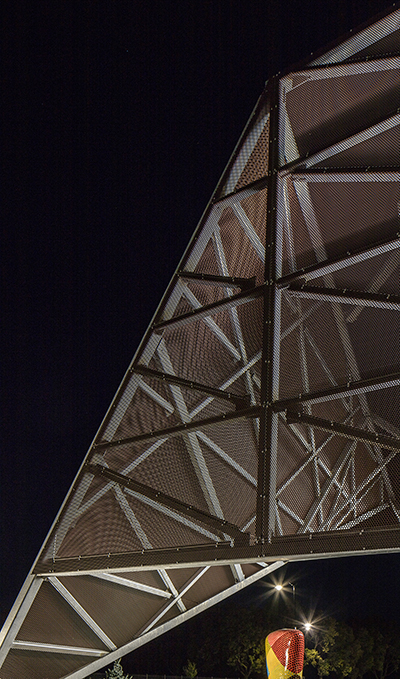 Jackson Dinsdale was passionate about art.
Jackson Dinsdale was passionate about art.
A studio art major at Hastings College in Hastings, Neb., he died unexpectedly in 2014 at the age of 21. But his artistic spirit now lives on in a state-of-the-art facility that honors his passion and generous nature.
Funded by his parents, college and community, the new $6.8 million, 24,600-sq.-ft Jackson Dinsdale Art Center (JDAC) on the Hastings College campus includes classrooms, galleries and studios for glassblowing, metal sculpture, ceramics, drawing, painting, printmaking and photography. In addition, the building is supported by an office suite, permanent collection storage and a wood shop.
Steel, glass and brick formed the palette the design team used to bring the school’s vision to life: a building designed functionally and materially to represent the three primary art instruction areas of metalworking (steel framing), ceramics (brick façade) and glassblowing (glass curtain wall). The interplay of these elements carries throughout the structure, and structural steel (110 tons in all), with its strength, lightness, durability, adaptability and variety made it the only material to fulfill the requirements for both the internal structural skeleton and external embellishments. Kully Pipe and Steel Supply, Inc., Hastings, Neb. (an AISC member and certified fabricator) was the project’s steel fabricator and detailer.
JDAC’s superstructure is comprised primarily of wide-flange steel supported by hollow structural sections (HSS) and wideflange steel columns. Infill framing consists of a combination of wide-flange steel beams and steel joists and HSS frames large window openings and roof monitors as well as forms diagonal braces (HSS5×5) to resist wind and seismic loads. As the steel framing is exposed to view in all locations, order and cleanliness were imperative to the structural design. Several additional steel elements envelop the exterior, including canopies at four locations and two large “scrim” structures. The canopies were designed as cantilevered elements, using pairs of steel channels to create the column and beam, and a custom bent-plate pan system forms the lid. This system is made of ¼-in. sheets bent to a shallow U-shaped panel with a 16-in.-wide base and 2½-in. verticals at each side. These elements are placed side by side to create the lid of each canopy, and the steel was hot-dip galvanized to resist corrosion. All these components connect in interesting ways and are left exposed to create a visually stimulating design that becomes a learning opportunity for the art students.
For more about the project, see the article “A New Angle on Art” in our current January issue (available now).